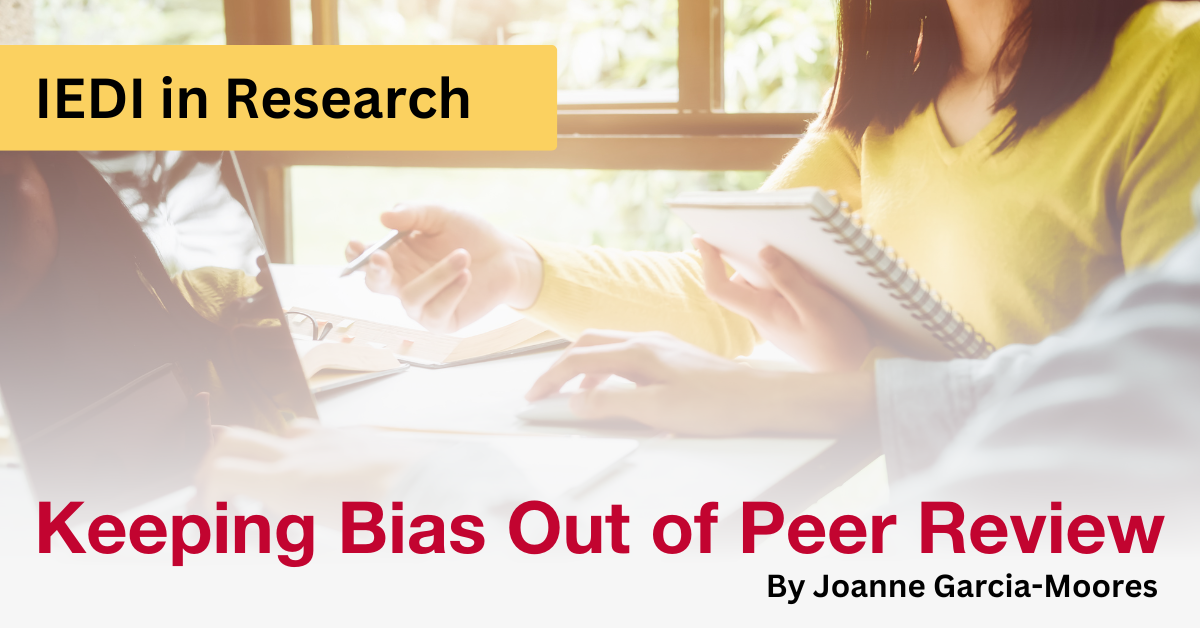By Joanne Garcia-Moores
Peer review is an important responsibility for many faculty. Providing fair and constructive evaluation and feedback makes a valuable contribution to the scholarship of those receiving the input and to research excellence in general. Peer reviewers hold considerable power to enable or curtail the further scholarly development of their colleagues. This power entails a significant responsibility to provide unbiased feedback that motivates further scholarly development rather than creating harm.
The difficulty is that bias is pervasive and often difficult to detect in ourselves and others.
As faculty committed to the values and principles of fairness and equity, as well as excellence in research, how can we ensure that our evaluations and feedback are unbiased, fair, and constructive?
First and foremost, your critiques must be substantiated. This means spelling out the specific gaps or areas for improvement you have identified in the paper or proposal. Use benchmarks to explain your assessments whenever possible. Avoid extrapolating from the gaps or errors you identify to make sweeping judgements about the proposal.
For example:
- If the proposal or paper is large and complex do not jump to the conclusion that it’s “overly ambitious”. Simply state that the project is large and complex relative to other similar projects you’re familiar with (benchmark) and that the proposal would have benefited from the inclusion of an explanation of how feasibility will be ensured.
- If the proposal or paper has some gaps in the literature review, do not infer that it “lacks diligence.” Simply state that you believe the project would benefit from consulting some additional literature in the area you identify as a gap. Note the type of benefit you expect.
- If the proposal or paper is grounded in older, well-established literature, it’s not constructive to share your view that it’s “out of touch with modern developments”. Simply, note the facts of the literature review and state that you believe the project would benefit from consulting more recent literature covering whatever developments you think are important and why.
- Conversely, if the literature review draws mainly on newer publications, don’t conclude that it’s “detached from the core tenets of the discipline.” Simply note the gap you’ve identified and explain how the project could benefit from drawing on particular core tenets.
These are all examples of providing opinions or judgements, rather than substantiated critique. Judgements and opinions are typically not constructive and will leave the reviewee with little clarity about how to continue developing as a scholar. Perhaps it will take a little more time and effort to fully explain and substantiate your observations but holding yourself to this standard will help ensure that your feedback is bias-free and contributes to research excellence.
Second, if you know the identity of the person whose paper or proposal you are reviewing, keep your review free from bias based on stereotypes. Stereotypes are mental shortcuts people use to categorize people and quickly respond to situations. But racial, gender, and other stereotypes associated with systems of prejudice and oppression can quickly lead to biased peer review.
For example:
- If the paper or submission you are reviewing needs some additional editing, do not conclude that because the author may not have English as their first language that “the paper needs to be edited by a native English speaker.” Simply state that the paper would benefit from additional editing to address spelling and grammatical errors that detract from overall quality.
- If the paper or submission you are reviewing contains many examples of expressive or wordy writing, do not conclude that because the author identifies as a woman, transgender, or non-binary person that “the writing is too emotional”. Simply state that in places more concise language would help to emphasize the significance of their conclusions.
- If the paper or submission you are reviewing centers worldviews that you are not familiar with, do not conclude that “Indigenous knowledge is not science”. Instead, if you feel you do not have the appropriate expertise to review then communicate this directly. Or take the opportunity to learn about the unfamiliar approach to research in your discipline.
- If the paper or submission you are reviewing centers the perspectives and priorities of the communities who are partners in the research, do not conclude that it “lacks theoretical relevance”, or that the “identity of the author/applicant as a member of the community they are researching makes it impossible for them to reach objective conclusions in their research.” Instead, note that drawing a few connections with relevant theoretical approaches could further strengthen the project.
- If the paper or submission you are reviewing draws on areas that seem to be outside the area of expertise of the reviewee, do not conclude that because they are an early career scholar that “they lack the network of collaborators necessary to ensure the success of the project.” Instead, suggest that adding information about collaborations with and contributions of other scholars would strengthen the project.
These are all examples based on stereotypes, including cultural, gender, racial, and career stage/age. Using stereotypes as the basis for your evaluations is at best unhelpful and at worst harmful. I hope the examples provided will make it easier to identify and avoid bias and provide your peers with the constructive feedback they need and deserve.
For more information about Bias in Peer Review this self-directed learning module by CIHR is helpful.


